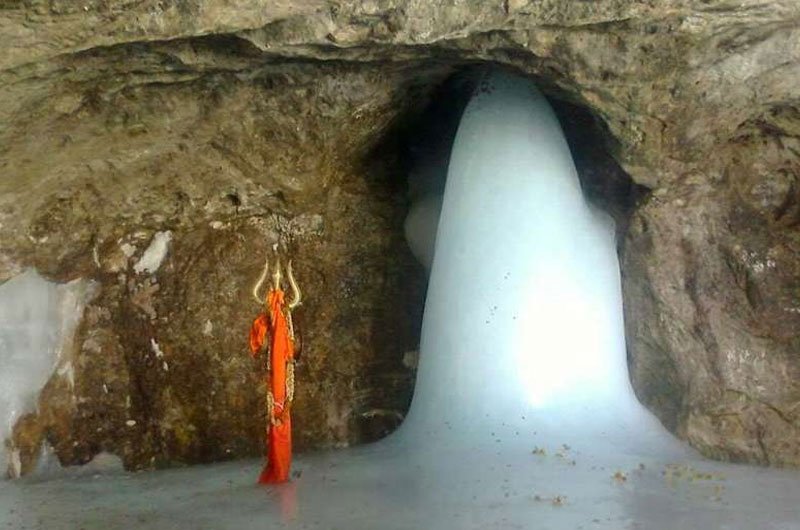
Amarnath Cave Temple: The Sacred Abode of Shiva in the Himalayas
Perched high in the snow-clad mountains of Jammu and Kashmir, the Amarnath Cave Temple is one of the most revered Hindu pilgrimage sites. Dedicated to Lord Shiva, the temple is renowned for its naturally occurring ice Shiva Lingam, which forms each year during the summer months. Nestled at an altitude of 3,888 meters (12,756 feet) above sea level, the Amarnath Cave Temple is a sacred site that draws thousands of devotees and adventurers seeking both spiritual solace and a challenging journey. This guide provides an in-depth look at the temple’s history, its unique features, nearby attractions, the best time to visit, and essential accommodation options for a memorable pilgrimage.
History of Amarnath Cave Temple
Mythological Origins
- Legend: According to Hindu mythology, the Amarnath Cave Temple is the site where Lord Shiva revealed the secret of immortality (Amar Katha) to his consort, Parvati. It is believed that Lord Shiva chose this remote cave for this sacred revelation, where the ice lingam naturally forms each year.
Historical Development
- Ancient References: The Amarnath Cave Temple has been a place of worship for centuries. Historical references can be found in ancient texts and scriptures, though its exact origins are shrouded in legend.
- Medieval Period: The temple gained prominence during the reign of various regional kings. It faced periods of neglect and destruction, but its significance continued to be recognized.
- Modern Era: In the 19th century, the temple was rediscovered by a shepherd named Buta Malik, who reported the discovery of the sacred shrine. Since then, it has become a major pilgrimage site, with the annual Amarnath Yatra organized by the Shri Amarnath Shrine Board (SASB).
Tourism Specialty and Locality
Unique Attractions
- Ice Shiva Lingam: The central attraction of the Amarnath Cave Temple is the naturally occurring ice Shiva Lingam, which forms due to the freezing of water dripping from the cave ceiling. This phenomenon is considered divine and attracts devotees from across the globe.
- Scenic Trek: The journey to the temple involves a challenging trek through rugged terrain and stunning landscapes. The trek offers breathtaking views of snow-capped peaks, alpine meadows, and glacial rivers.
- Holy Cave: The cave itself is a natural formation surrounded by mountains, adding to its spiritual and mystical appeal.
Locality
- Location: The Amarnath Cave Temple is situated in the Anantnag district of Jammu and Kashmir, India. It lies at an altitude of 3,888 meters (12,756 feet) in the Himalayas.
- Accessibility: The temple is accessible via a trekking route from Pahalgam or Baltal. The nearest town with regular connectivity is Pahalgam, which is around 95 kilometers from the cave.
Best Time to Visit
Ideal Seasons
- Summer (June to August): The best time to visit the Amarnath Cave Temple is during the summer months when the weather is relatively mild and the ice Shiva Lingam is fully formed. The Amarnath Yatra, a significant pilgrimage period, takes place during this time.
- Winter (November to March): The cave is generally closed during the winter months due to heavy snowfall and extreme cold, making travel extremely challenging.
Peak Seasons
- Amarnath Yatra (July-August): This annual pilgrimage season is the peak time to visit, with thousands of devotees trekking to the temple. The Yatra usually begins in late June or early July and ends in August on the day of Raksha Bandhan.
Nearby Tourist Spots
Pahalgam
- Significance: Known as the “Gateway to Amarnath,” Pahalgam is a picturesque town with lush meadows, scenic views, and a pleasant climate. It serves as the base for the Amarnath Yatra.
- Distance: 95 kilometers from the Amarnath Cave Temple.
Sonamarg
- Significance: Famous for its breathtaking landscapes and as a starting point for various treks and adventures, Sonamarg is a serene destination with beautiful valleys and rivers.
- Distance: 80 kilometers from the Amarnath Cave Temple.
Betaab Valley
- Significance: A beautiful valley named after the Bollywood film “Betaab,” it is known for its verdant meadows, clear streams, and panoramic views.
- Distance: 100 kilometers from the Amarnath Cave Temple.
Yusmarg
- Significance: A tranquil meadow located at an altitude of 2,400 meters, Yusmarg is known for its picturesque scenery and serene environment, offering a peaceful retreat.
- Distance: 80 kilometers from the Amarnath Cave Temple.
Nearby Restaurants
Pahalgam Restaurant
- Cuisine: Offers a variety of North Indian and Kashmiri dishes, including traditional rogan josh, gushtaba, and more.
- Location: Main market area, Pahalgam.
The Troutbeat
- Cuisine: Specializes in fresh trout fish dishes and other local delicacies.
- Location: Pahalgam.
Shamyana Restaurant
- Cuisine: Known for its diverse menu including Indian, Chinese, and continental dishes.
- Location: Main Road, Pahalgam.
Nearby Hotels
Hotel Hilltop
- Features: A comfortable hotel with modern amenities, including well-furnished rooms, dining options, and stunning views of the surrounding mountains.
- Location: Pahalgam, 95 kilometers from Amarnath Cave Temple.
Hotel Grand Mumtaz
- Features: Provides luxurious accommodations with various facilities including a multi-cuisine restaurant and excellent service.
- Location: Pahalgam, 95 kilometers from Amarnath Cave Temple.
Hotel Trident
- Features: Offers upscale amenities, including spacious rooms, a restaurant, and easy access to local attractions.
- Location: Pahalgam, 95 kilometers from Amarnath Cave Temple.
The Pilgrimage Experience
Trekking to the Temple
- Routes: The two main routes to the temple are from Pahalgam and Baltal. The trek from Pahalgam is longer but relatively easier, while the Baltal route is shorter but more challenging.
- Duration: The trek from Pahalgam to the temple takes about 3 to 5 days, depending on the pace and weather conditions.
Temple Visit
- Entry Requirements: Pilgrims are required to obtain a permit for the Amarnath Yatra, which can be secured through the Shri Amarnath Shrine Board (SASB).
- Dress Code and Preparation: The trek involves harsh weather conditions, so pilgrims should dress in layers, wear sturdy trekking shoes, and carry essential items like rain gear, water, and high-energy snacks.
- Aarti and Offerings: The temple hosts several aartis (rituals) during the day. Pilgrims can offer prayers and seek blessings at the cave shrine.
Accommodations for Pilgrims
Temporary Camps
- Features: During the Amarnath Yatra, temporary camps are set up along the trekking routes and near the temple to accommodate pilgrims. These camps provide basic facilities such as bedding and food.
- Location: Located at various points along the trekking routes from Pahalgam and Baltal.
Dharmashalas
- Features: Budget-friendly lodgings managed by religious and charitable organizations. These facilities offer simple and clean accommodations.
- Location: Available in Pahalgam and Baltal.
Concluding Thoughts
The Amarnath Cave Temple, with its divine significance, majestic setting, and challenging journey, represents a profound spiritual and physical adventure. The annual Amarnath Yatra is not just a pilgrimage but a journey of faith and endurance. Whether you are seeking spiritual enlightenment or wishing to experience one of India’s most challenging and awe-inspiring treks, the Amarnath Cave Temple offers an unforgettable experience. By planning your visit during the optimal season, exploring nearby attractions, and choosing appropriate accommodations, you can ensure a fulfilling and memorable pilgrimage to this sacred Himalayan shrine.
